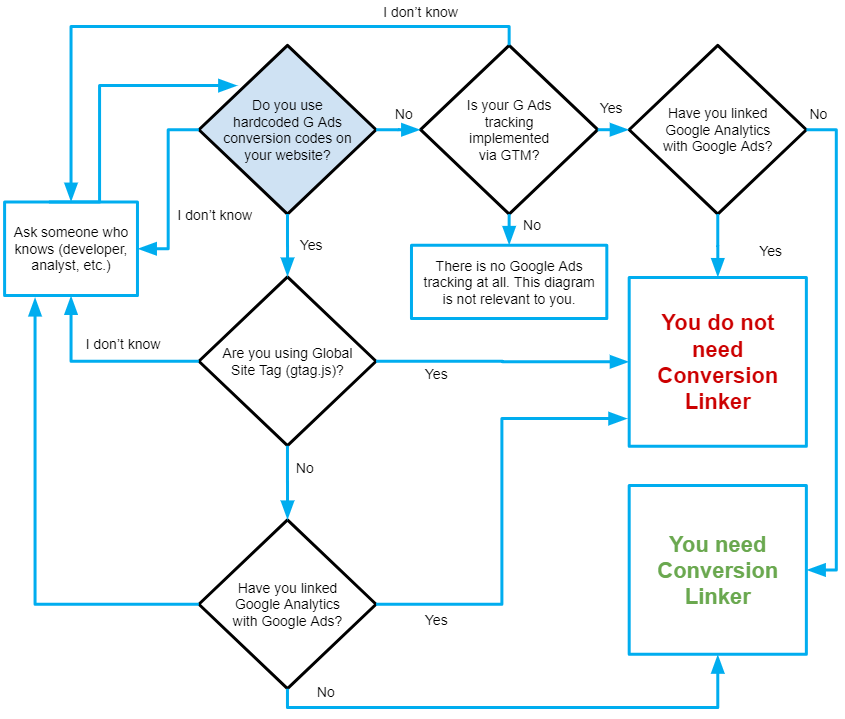Updated: August 24, 2018. In June 2017, Apple announced Intelligent Tracking Prevention (ITP), an initiative aimed at limiting third-party trackers from capturing cross-site browsing data and it will be launched really soon (or maybe it already is? Honestly, I’ve lost the track). This might become a problem for those who are using Google Ads (previously known as Google Adwords) because the ITP will block cookies which are an essential part of G Ads Conversion Tracking.
In response, Google introduced several ways how to decrease the impact of the Intelligent Tracking Prevention. Conversion Linker Tag is one of those solutions. Do you need it? Everything is explained in this blog post.
What is Intelligent Tracking Prevention?
In short, with ITP, third-party cookies that are determined to be able to track users across sites can only be used for 24 hours from the time a user visits a website via Safari. After 24 hours, the third-party cookies can only be used for log-in purposes. The cookies are purged entirely after 30 days.
![]()
Why is that important? Google Ads uses 3rd-party cookies for conversion tracking, therefore, ITP will break it and all conversions that happen after 24 hours from the time a user lands on your page will not be tracked.
What are the possible solutions?
Actually, there are three options, choose one:
- You can link GA with Google Ads (if you haven’t already) and you’re good to go. Google Analytics uses 1st party cookies and shares the data with G Ads, thus your conversion tracking will continue working properly.
- If you have new websites you wish to track and you do not want to use Google Tag Manager (I see no reasons why would want to you avoid GTM
 ), start using the new Global Site Tag (gtag.js). Recently, Google announced this tracking method with the intention to streamline tracking across Google products, including their “measurement, conversion tracking, and remarketing products.” For now, Google Analytics, Google Ads and, in the future, other Google Products will use tracking codes of the same structure and technology behind it. Go ahead to Google Analytics or G Ads Conversion’s settings and you’ll see that they are already recommending gtag.js (see the example below)
), start using the new Global Site Tag (gtag.js). Recently, Google announced this tracking method with the intention to streamline tracking across Google products, including their “measurement, conversion tracking, and remarketing products.” For now, Google Analytics, Google Ads and, in the future, other Google Products will use tracking codes of the same structure and technology behind it. Go ahead to Google Analytics or G Ads Conversion’s settings and you’ll see that they are already recommending gtag.js (see the example below)
- If you’ve installed G Ads Conversion Tracking via Google Tag Manager AND haven’t linked it to Google Analytics (well, maybe you use another analytics tool), start using Conversion Linker Tag. In this blog post, I’ll explain how to set it up.
What is Conversion Linker Tag in Google Tag Manager?
When people click on your ads, the URL of the landing page (of your website) typically contains ?gclid=xxxxxxxx. This ID is saved as the 3rd party Google Ads cookie.
When a site visitor takes an important action that you’ve tagged as a conversion, a Google Ads conversion tracking tag is fired. As a result, the ad click information (gclid) is used to associate that conversion with the ad click that brought the visitor to your site.
Once the ITP goes live, that Google Ads 3rd party cookie will be functional only for 24 hours after a visitors visits your site. The solution? Conversion Linker Tag!
This tag automatically detects the ad click information in your landing page URLs, and stores this information in 1st party cookies on your domain (instead of 3rd party cookie), meaning that ITP will no longer affect the Google Ads conversion tracking and you’ll be able to measure important conversions even after 24 hours after a visitor lands on your page.
How to set up Conversion Linker Tag In GTM?
Luckily, it’s really easy.
- In Google Tag Manager, go to Tags.
- Choose Conversion Linker as a Tag Type.

- And set it to fire on All Pages. No other configuration is necessary.

Done! Publish the updated Google Tag Manager to live environment. Before that, don’t forget to test the tag with Preview and Debug mode.
Optional: Additional Configuration in Conversion Linker (Advanced)
By default, the Conversion Linker tag sets ad click information in cookies named _gcl_aw and _gcl_dc using the top-most domain and root level path. And that sufficient for this tag to work. But if you need to override any of its settings, you can do so in the Linker Options.
You should only adjust the settings if you have a specific need that requires it and you really know what you’re doing. For example, you may need to override some cookie settings if you:
- already have cookies with the same names (_gcl_aw and _gcl_dc).
- need to have multiple sets of cookies.
- or don’t want ad click info from one subdomain of your website to be available for conversions on another subdomain.
When you select the Override cookie settings option, fields for Name, Domain, and Path will appear:
- Name: This is the prefix used as part of the cookie names. The default prefix name is _gcl. For example, if you change the Name to _gcl2, the Conversion Linker tag will set cookies named _gcl2_aw and _gcl2_dc.
- Important: If you change the prefix of the cookie names, any tags that read ad click info from these cookies (e.g. G Ads conversion tracking tags) must also be configured to use the same prefix.
- Domain: This is the domain of your website on which the first-party cookies should be set. By default, the Conversion Linker tag will use the highest level domain on which it can set cookies. For example, if your website address is support.yourdomain.com, the Conversion Linker tag will set the cookie domain to yourdomain.com. Only set this field if you need to limit the cookies to a lower-level domain, e.g. only for support.yourdomain.com
- Path: This is the path used to set the cookies. By default, the cookie path will be the root level (/). Only set this field if you need to limit the cookies to a subdirectory of a domain, e.g. only for yourdomain.com/posts.
TL;DR: Do you need to use Conversion Linker?
If you’re in a hurry, here’s a brief flow chart which will help you understand whether you need to use conversion linker in web tracking implementation. Start from the blue diamond.

Conversion Linker: Final Words
If you’re tracking Google Ads conversions with Google Tag Manager, you need to start using Conversion Linker Tag as well. In June 2017, Apple introduced a solution which will seriously limit 3rd party tracking cookies and (surprise!) G Ads cookies are one of them.
In order to keep tracking important events with Google Ads precisely, you need to start using Conversion Linker tag as well.
You do not need this tag if you:
- Have linked Google Analytics account to Google Ads.
- Or you are tracking Google Ads conversions by using the new Global Site Tag (gtag.js).
The post What is Conversion Linker in Google Tag Manager? appeared first on Analytics Mania.
Source: analyticsmania
